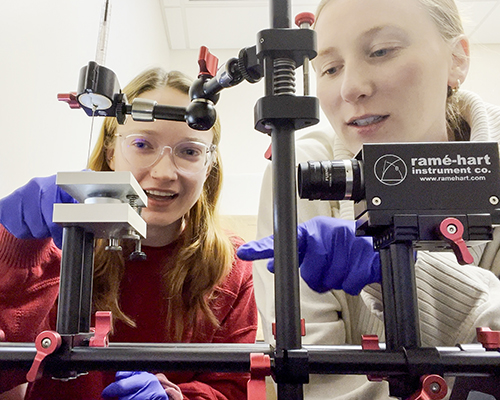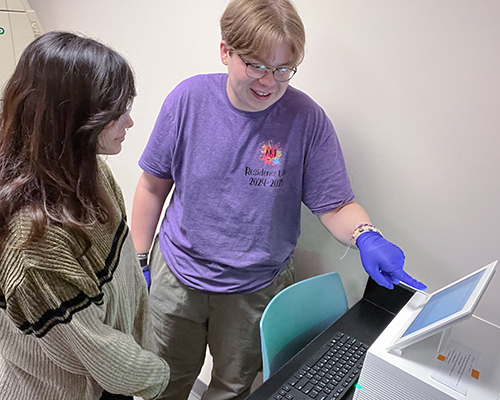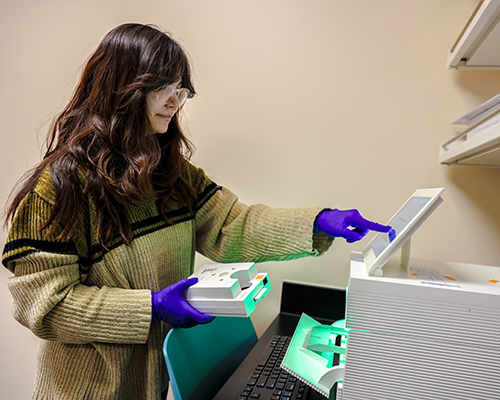Cornell biochemistry students can now get their hands on two new lab instruments to learn research and career skills for the future.

The Russell Science Center houses a new DNA sequencer and contact angle goniometer, and students are already using these instruments in their classes. This is part of the implementation of a grant from the Sherman Fairchild Foundation, which awarded the college a total of $500,000 to fund new STEM equipment and upgrade facilities on campus.
“Providing our students with access to this new equipment, that undergrads usually don’t have access to, is really important,” said Associate Professor of Biochemistry Catherine Volle, who wrote the grant and is in charge of its implementation. “I think these types of opportunities are why our students are so successful once they leave—why they go to grad school, why they go to industry, why we have recruiters who specifically want to recruit our students—because of our hands-on teaching techniques and the experiences they get here.”
The goniometer measures the contact angle of drops of liquid on a surface. This will be helpful within the Volle lab as the team continues its research into antibiotic resistance.

“The goniometer will be helpful because we are interested in how bacteria attach to surfaces,” Volle said. “We wanted to be able to make different kinds of surfaces with various characteristics. One of the ways we know that we have created a surface successfully is often a change from a hydrophobic surface, [one that repels water], to a hydrophilic surface, [one that attracts and interacts well with water]. The goniometer will tell us that.”
Juniors Jonathan Raper ’26 and Bailey Williams ’26 used the DNA sequencer during their Block 5 Genetics course.
“DNA is broken down into A, T, C, and Gs,” Raper explained. “Essentially what this machine does is take a region of DNA that we’re interested in, and we can get that A-C-G-T sequence to determine mutations or differences between DNA samples.”
Both Raper and Williams say it’s invaluable to have professors who care about them and who worked together to secure this grant for Cornell students to have successful futures.
“Through having experiences with these types of instruments, we stand out as applicants when we apply for internships or research opportunities,” Williams said. “I think it’s really exciting.”
What’s already finished?
 This is the second year of implementing the STEM grant at Cornell. Last year, the college completed upgrades to a room in Norton Geology and transformed it into a Geographic Information Systems (GIS) Lab. The room provides a collaborative space that makes it easier for students to get more hands-on with GIS than the typical Cornell College classroom. Contractors upgraded the electrical systems and installed new carpet, projector, transitional seating, and two dozen large monitors.
This is the second year of implementing the STEM grant at Cornell. Last year, the college completed upgrades to a room in Norton Geology and transformed it into a Geographic Information Systems (GIS) Lab. The room provides a collaborative space that makes it easier for students to get more hands-on with GIS than the typical Cornell College classroom. Contractors upgraded the electrical systems and installed new carpet, projector, transitional seating, and two dozen large monitors.
What’s next?
Faculty and IT staff are planning to construct and install Cornell’s new high-performance computing cluster (HPCC). The HPCC will allow Cornell students to analyze large sets of data, which requires a lot of processing power. In the past, professors were limited to smaller data sets or had to buy time on a larger server located elsewhere to analyze data for research.
“We’re excited for our students to work with big data right here on campus,” Volle said. “This hands-on experience is key for many future STEM careers, and the new HPCC will make it possible."
Professors are also starting to complete assessments and gather data to see how the equipment impacts students and their science identity. Volle says students report higher confidence in their scientific skills and more strongly identify as scientists after completing a science course, which was particularly pronounced in first-year students. Students majoring in a STEM field were more likely to report increased confidence in their ability to do science and their scientific identity than non-majors, while non-majors reported an increased understanding of how scientists think.